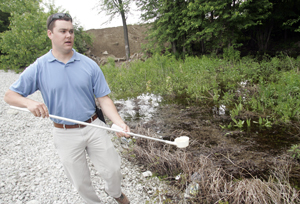
Monitoring
We have worked closely with the
Tippecanoe County Health Department in mosquito monitoring and West Nile virus surveillance.
Typically, from June through September, special traps that attract and capture female mosquitoes are
placed weekly at several locations in the county. Two types of trap are used. A
dry ice trap produces a plume of carbon dioxide that attracts females searching for a source
of a blood meal. The attracted mosquitoes are then drawn in closer to a small incandescent light and
gently blown down into a collecting bag by a fan. A
gravid trap is comprised of a small tub with "smelly" water that attracts female mosquitoes
searching for a place to lay eggs. The attracted females are gently sucked up into a collecting
bag by a fan. Gravid traps are particularly good for monitoring West Nile mosquitoes in the genus
Culex, the females of which are noted for laying egg "rafts" on polluted water.
Female mosquitoes captured in both types of traps are identified and those of certain species, primarily
Culex mosquitoes, are shipped to the Indiana State Department of Health where they are processed
in a lab and checked for evidence of West Nile virus.
We have also assisted the Tippecanoe County Health Department in monitoring standing water habitats
and container habitats for the presence of mosquito larvae. Over 1,100 visits were made to existing,
suspected, and past larval habitats in Tippecanoe County from May 2003 to October 2006, with 639 collections
of mosquito larvae made through October 2006. Larvae are collected, identified, correlated with the specific
habitat, and the information entered into a database developed by R. J. Beck at the Tippecanoe County
Health Department. GPS location of collections provides a useful mapping tool regarding larval developmental
sites. Data pertaining to mosquito larvae and specific larval habitats can be accessed, correlated with
recent rainfall or flooding, and serve as a guide for source reduction efforts and directing necessary
control of mosquito larvae. Surveillance and control have been focused on standing water habitats
and container habitats in and around urbanized areas of Tippecanoe County that are sources of species
of
Culex mosquitoes known to be involved in West Nile virus transmission.
Readers interested in learning about the incidence and distribution in the USA of West Nile virus cases
in humans are referred to
diseasemaps.usgs.gov
. This website is based on yearly data from the Centers for Disease Control and Prevention (CDC)
starting in 2000, following the appearance of West Nile virus in New York in 1999. Data are reported
and mapped for the USA, individual states, and counties within states. In 2010, 1, 021 human cases West
Nile virus were diagnosed in the USA, 13 of which occurred in Indiana. The vast majority of Indiana cases
were reported from the northern tier of counties, and nearly all were documented from late July into
mid-September, with a peak in August.
The USGS Web site also includes similar data in the USA for horses and mosquitoes infected with West
Nile virus. In 2010, 157 cases were diagnosed in horses, 6 of which were in Indiana, and 10, 088 positive
"pools" of mosquitoes, 328 of which were in Indiana. A "pool" is a group of
up to 100 female mosquitoes belonging to a single species or a genus (when it is not possible to accurately
identify individuals to species). In Indiana, nearly every positive pool involved
Culex mosquitoes.
Summaries of Monitoring Mosquito Larvae in 2003-2006
In 2009, the Tippecanoe County Health Department discontinued mosquito surveillance activities. A summary of the Purdue Public Health Entomology mosquito surveillance program activities, conducted in partnership with the Tippecanoe County Health Department between 2003 and 2008, and mosquito surveillance data from this period are provided here.
Readers are encouraged to read the Web site section on mosquito biology and refer to life cycle diagrams
to better understand the following reports, which focus on major nuisance species in the genus
Aedes and the genus
Psorophoraand vectors in the genus
Culex. Larvae of
Anopheles species are collected in a variety of standing water sites, but not in large
numbers. Data on these species and other mosquito species together their larval habitats in Tippecanoe
County are available upon request.
General themes emerged during monitoring of mosquito larvae in 2003 that have continued in subsequent years. Larvae of major nuisance species and vector species typically are associated with floodwater habitats and/or habitats created by or associated with human activities. The latter include runoff catch basins, wheel ruts, roadside ditches, and a variety of container habitats such as discarded tires, untended wading pools, open barrels, and improperly suspended gutters. Water polluted by decaying vegetation (leaves or grass clippings) and animal feces, including human feces associated with failing septic systems, often supports the development of large numbers of vector species in the genus Culex. On the other hand, bodies of non-polluted water that supports natural aquatic vegetation, fish, and other predators of mosquito larvae are a source of relatively very few mosquitoes, mostly representing species such as Culex territans and Uranotaenia sapphirina whose females do not feed on humans.

